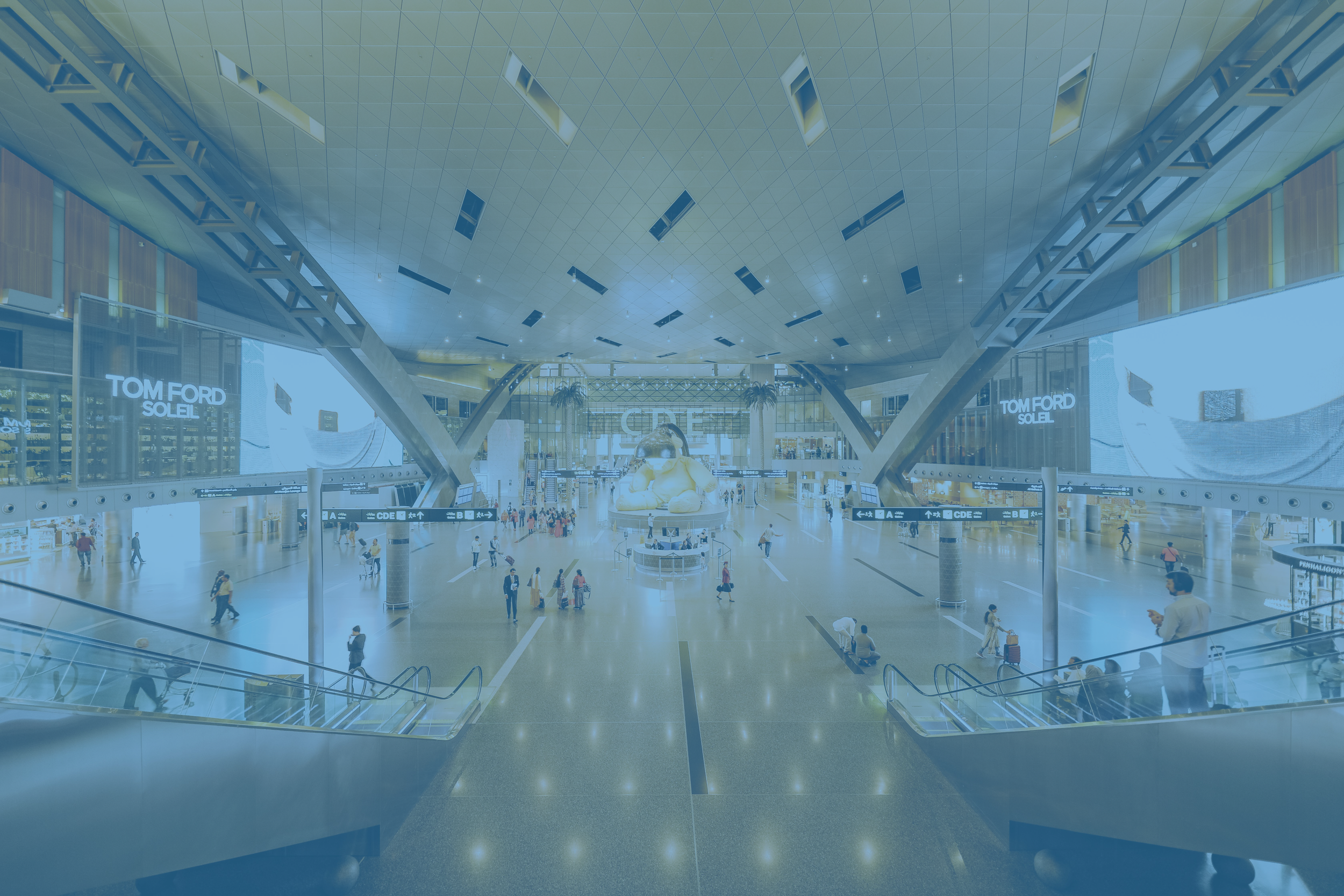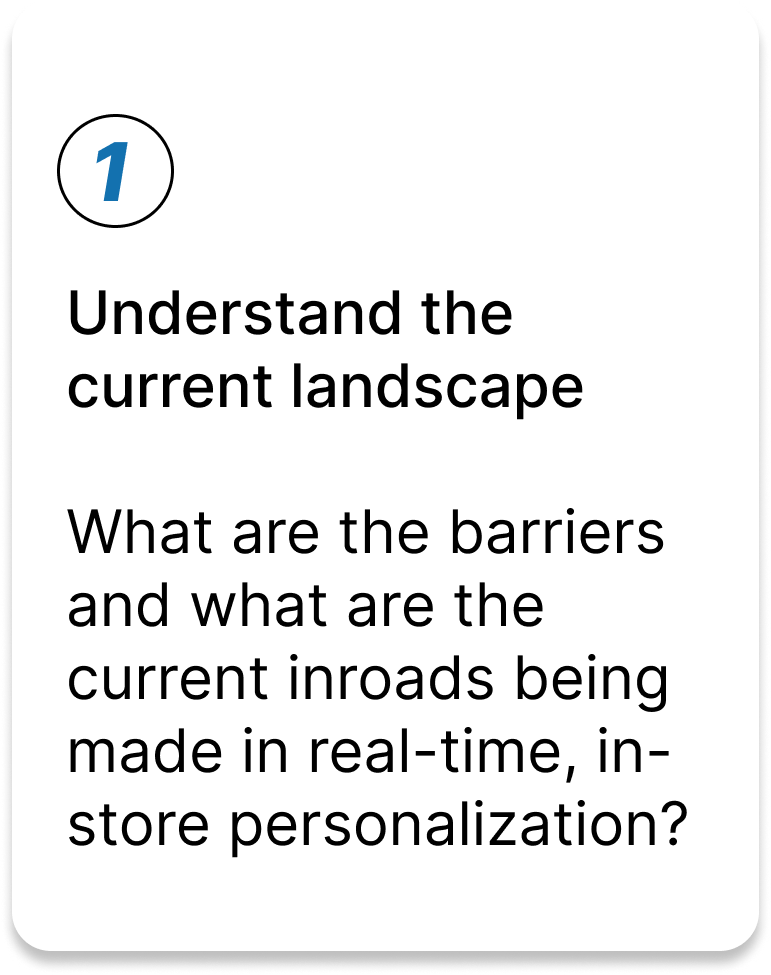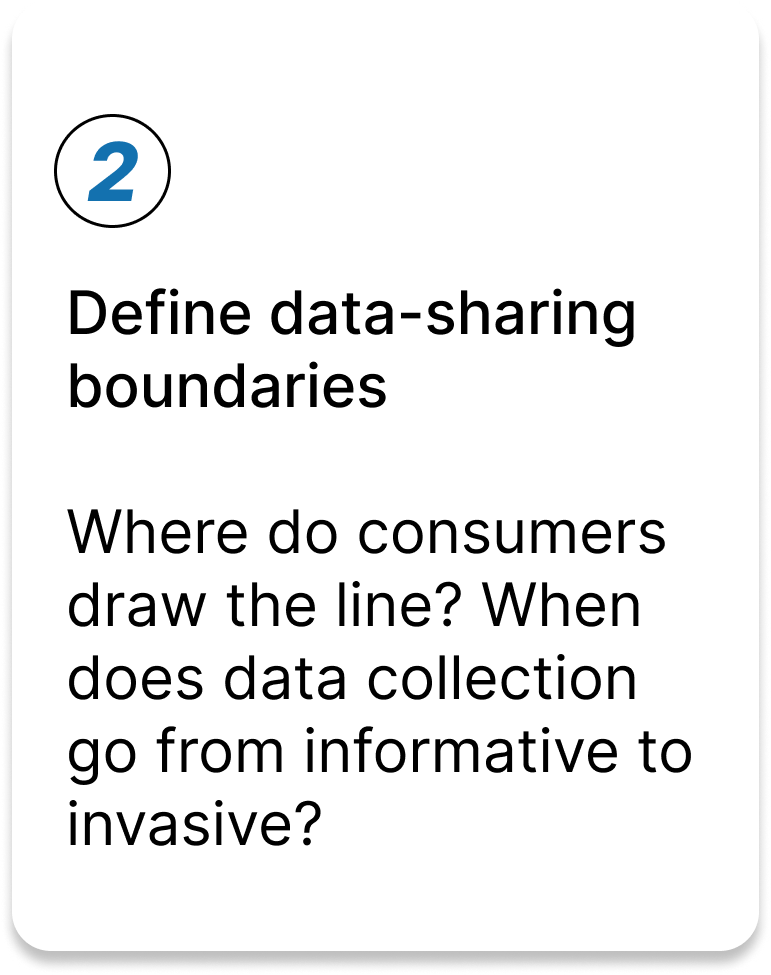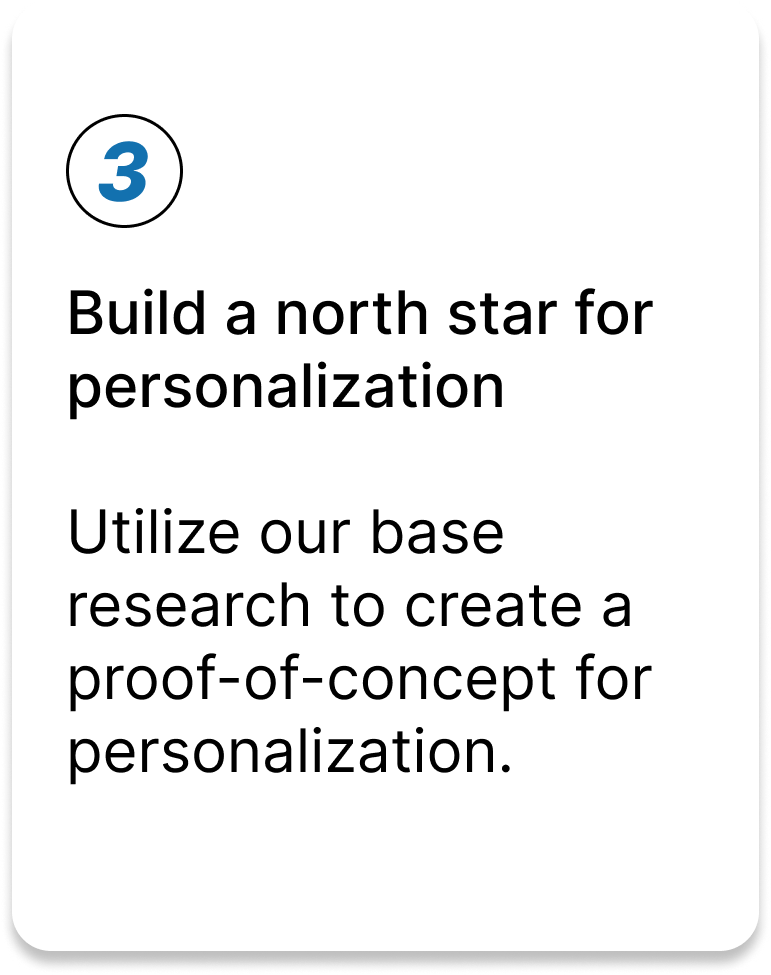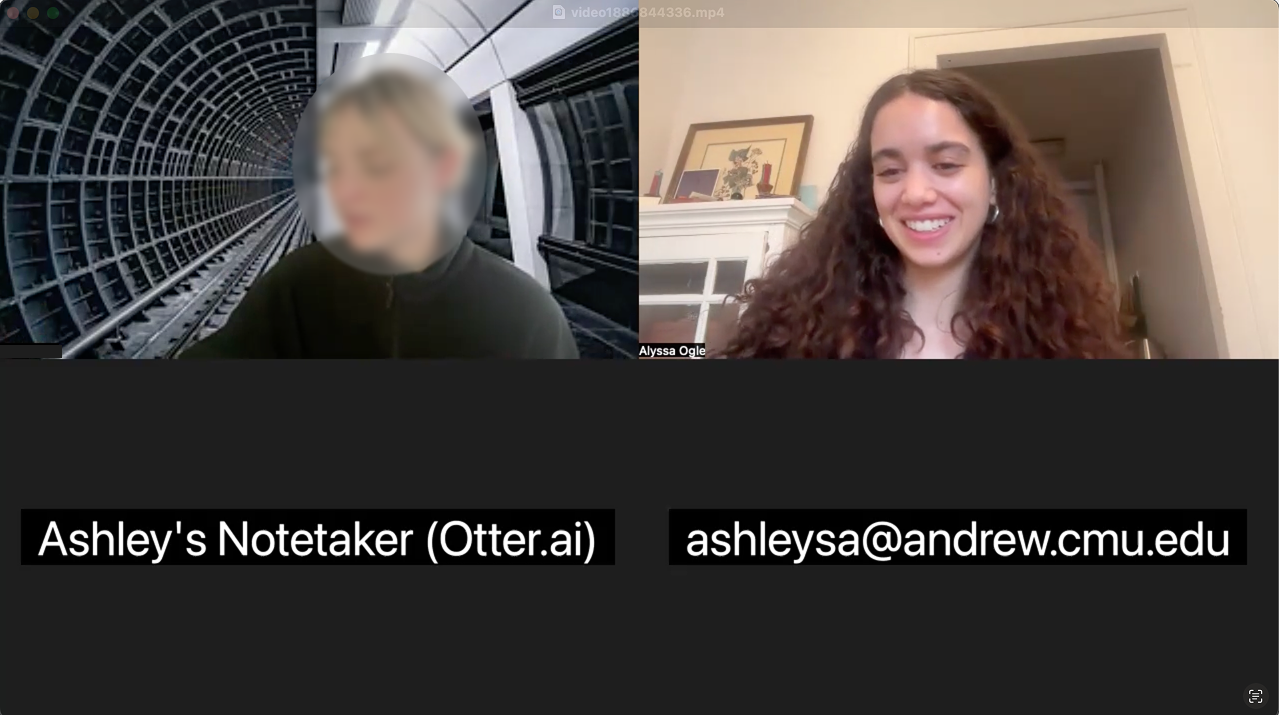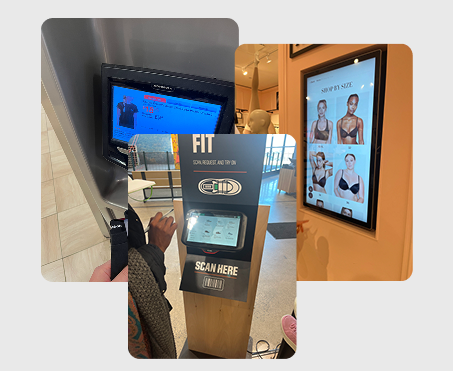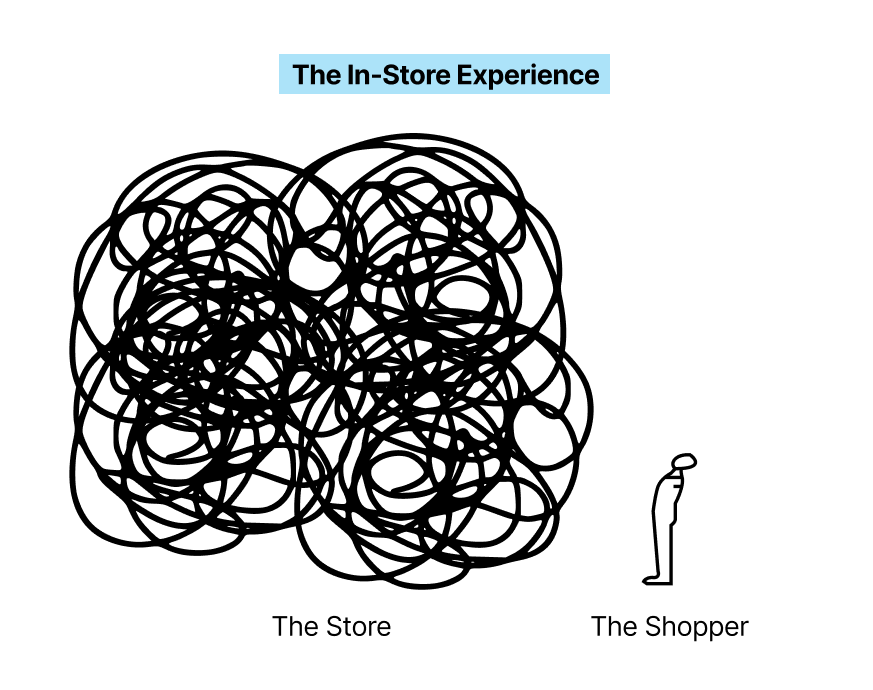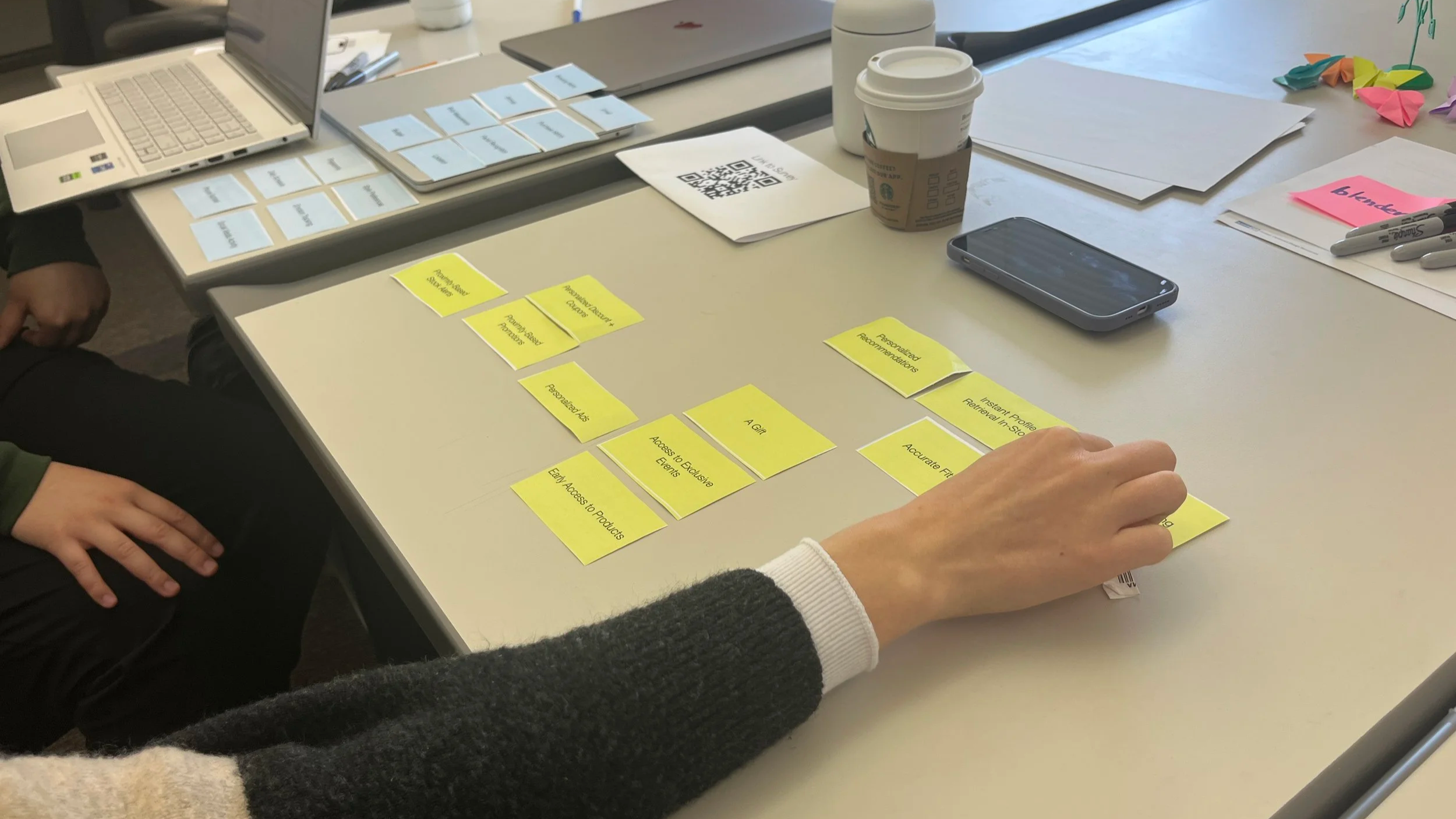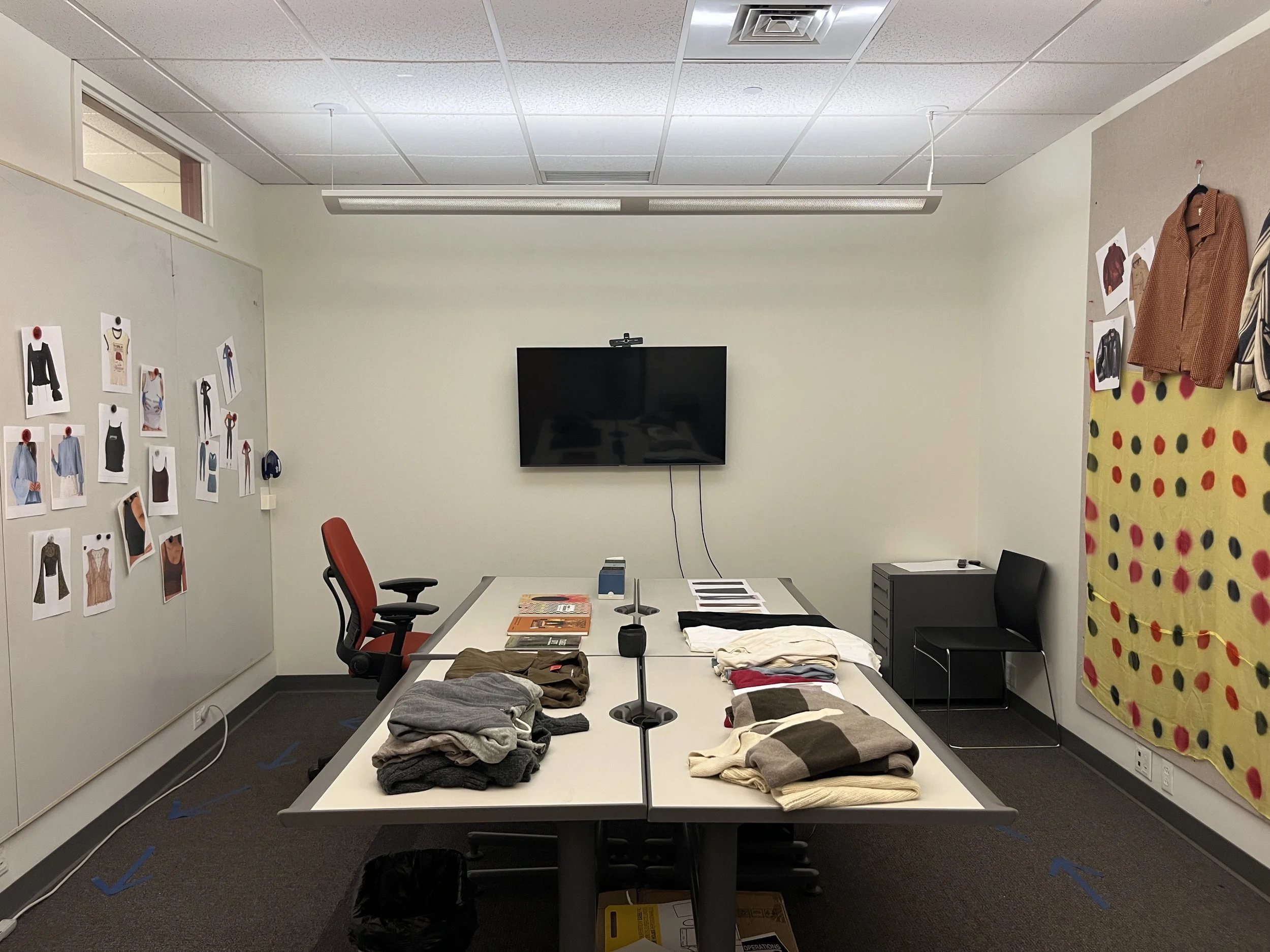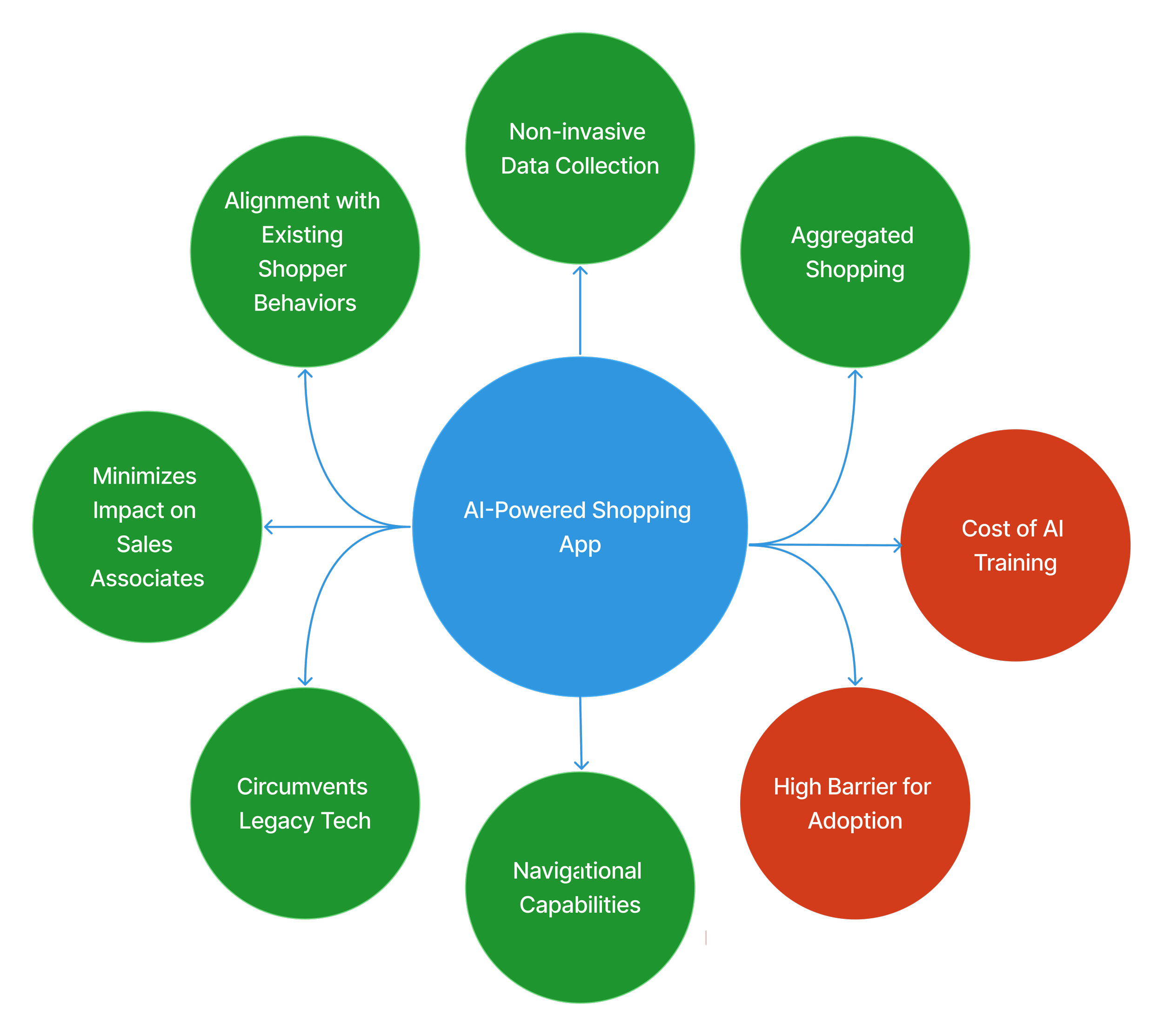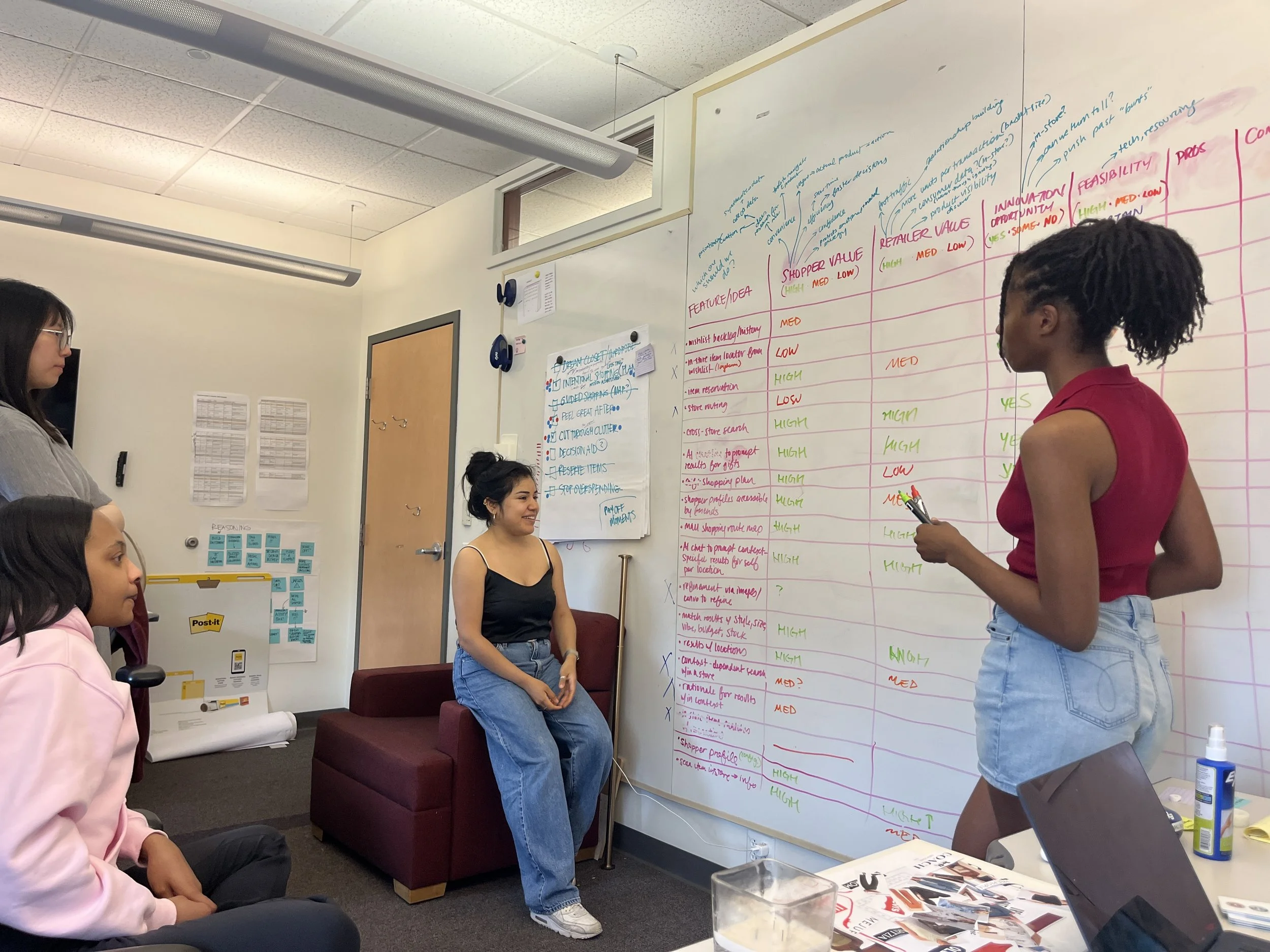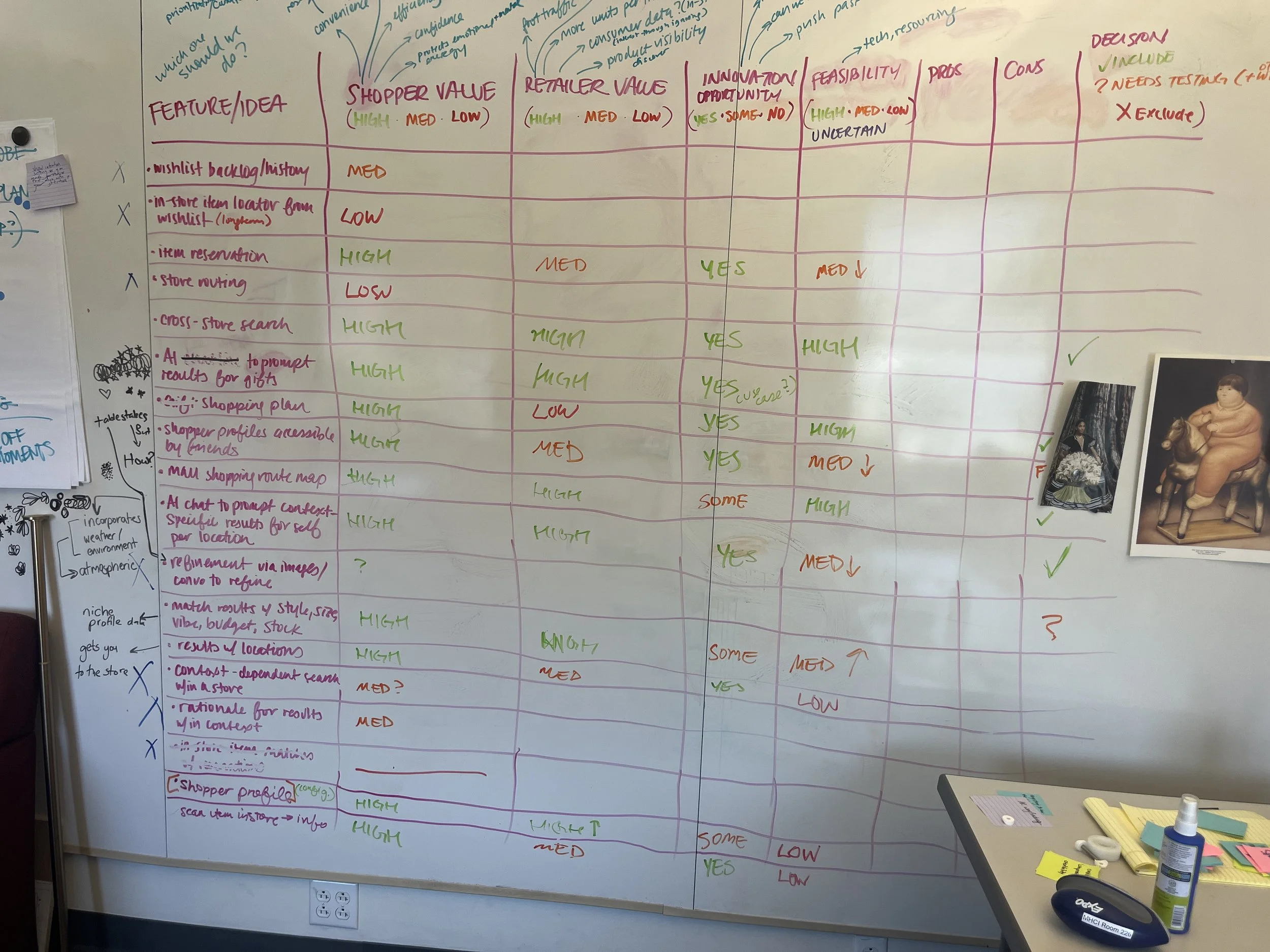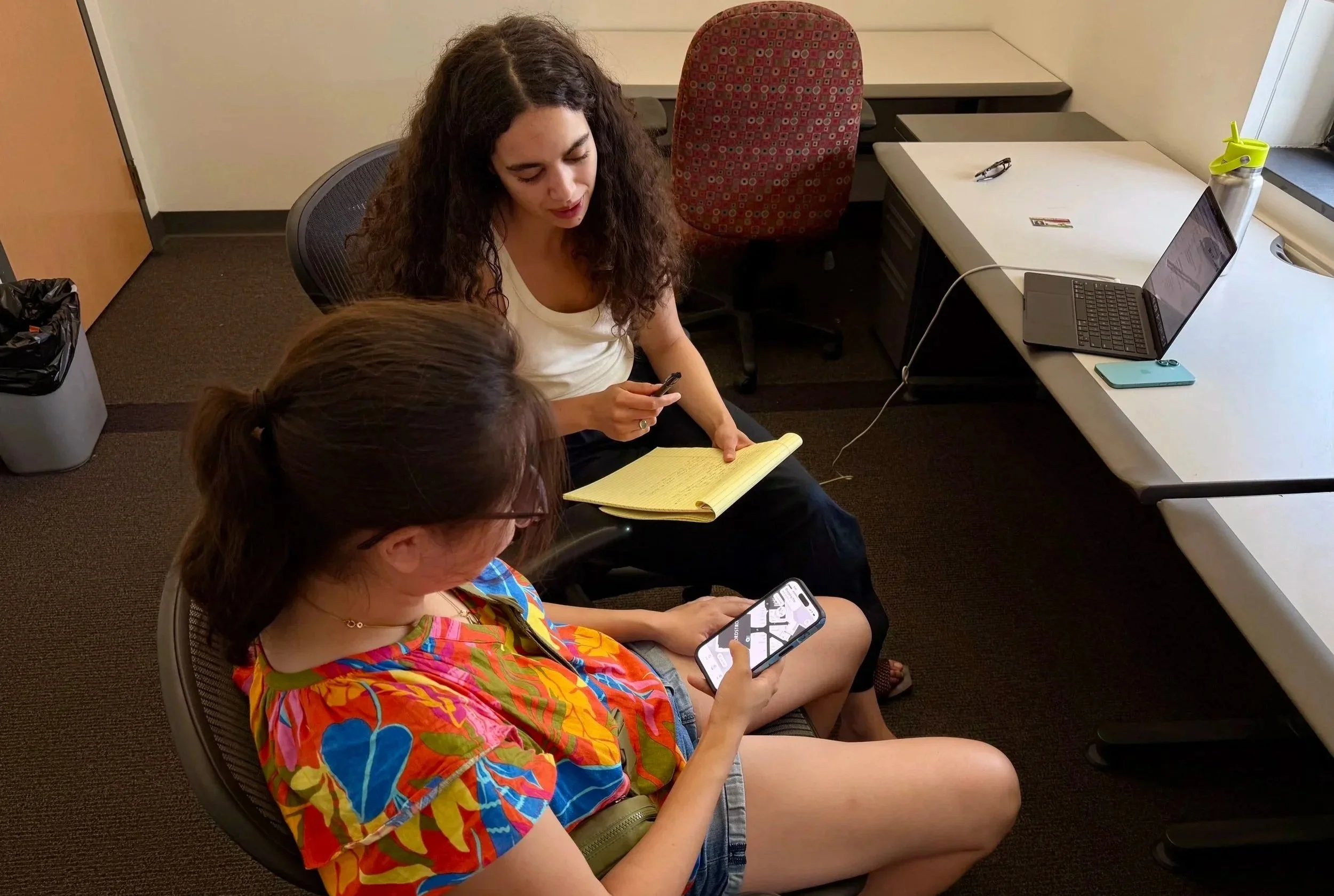Cerulean, the shopper-first shopping app
A journey into understanding, designing, and implementing real-time, in-store personalization.
Role
Researcher on a team with 2 designers, 1 engineer, and 1 PM
Client
ENAiBLE – CMU’s academic retail collective
Duration
8 months, 01/25 – 08/25
Scope
0-1 Product Development
Real-time personalization is ubiquitous to our shopping experiences online, so why is this level of personalization missing in-person?
However, why does this matter? Because the retail industry needs a sea change: a dismal 9% of shoppers are satisfied with their current shopping experience (IBM 2024).
ENAiBLE believes real-time, in-store personalization can elevate retail and tasked our team with 3 core objectives within our project space.
At a Glance
The Problem
The Solution
Cerulean, a store-agnostic shopping app that empowers every user to confidently navigate in-person shopping.
81% of shoppers conduct online research before shopping (Andersen 2025). The current process – separately searching individual digital repositories is slow and disjointed.
Cerulean expedites and consolidates, creating a personalized game plan for shopping that removes the guesswork and uncertainty.
The Experience
In-store shopping simplified with Cerulean.
Fig 1. The process of using the Cerulean app
Our Approach
We had four phases in the process of creating Cerulean.
P1 Discovery Understand the current landscape of in-store shopping and personalization.
P2 Analysis Define the pain points within the in-store shopping experience to guide our design.
P3 Ideation Solve for these uncovered pain points.
P4 Refinement Iterate upon the design, ensuring a clear value proposition for key stakeholders, retailers and shoppers.
P1 Discovery
Purpose of this phase
The discovery phase of our research process focused on aligning goals and objectives with our client and immersing ourselves in the world of retail and personalization. It was split into four stages.
Client Alignment
Fig 2. Trend map activity at the kickoff workshop with our client
Determine the driving forces for this project. We needed to answer some core questions about our client’s assumptions, expectations, and unknowns.
This was done through our kickoff workshop.
My goal for this stage
What I learned
Validate and invalidate ENAiBLE’s hypotheses. Our client believed legacy tech and organizational barriers had inhibited the implementation of real-time, in-store personalization
Explore broadly and thoroughly. The space of in-store, real-time personalization was relatively new to them so expansive exploration was encouraged.
A Secondary Sweep
Fig 3. Sample of articles reviewed for the secondary research component.
My goal for this stage
Build a solid foundation. I utilized this period of secondary research to ensure I had a basic understanding of the problem space to optimize future conversations with SMEs
What I learned
Developing the right vocabulary. I was able to gain proper industry terminology i.e. omnichannel, setting me up for more seamless conversations with SMEs.
Learning about stalled efforts. Seeing articles about initiatives that had fizzled created interesting kindling for future SME conversations.
Attaining the framework. Learning the basic formula for personalization – right product to the right person at the right time – offered great value.
Speaking with Experts
Fig 4. A field visit to Dick’s House of Sports in Ross Park Mall with my teammates and a retail SME
My goal for this stage
Deepen my understanding of the current landscape. My team and I connected with 15 SMEs with expertise in tech and apparel retail or both to gain an in-depth understanding of personalization’s current state.
What I learned
Personalization to gain a connection. Retailers are eagerly pursuing in-store personalization and want to utilize personalization as a method for connecting with shoppers
Sale associates are the nexus. Currently, retailers are focusing their approach on augmenting the ability of sales associates and are targeting loyalty account holders.
The barriers do frustrate the process. Legacy technology and organizational silos, as predicated, create key complications.
Learning from Shoppers
Fig 5 and 6. An in-depth, semi-structured interview with a shopper
My goal for this stage
Solve for actual issues. Good design addresses an existing problem. We spoke with 15 shoppers to understand the current frustrations and positives of in-person shopping.
What I learned
The tangibility can’t be beat. Shoppers greatly value the tactile component of in-person retail.
The overwhelm effect. Overwhelm and stock uncertainty proved to be significant pain points for shoppers.
Data-sharing willingness. Shoppers will share data for a valuable reward.
The era of the hybrid shopper. Regardless of age, our shoppers used their phones extensively throughout their entire shopping journey from preparation to checking out.
P2 Analysis
Purpose of this phase
After gathering a rich and comprehensive data set, we dove headfirst into the analysis phase.
My approach to the analysis was focused on finding the points of tension within the two key stakeholders: retailers and shoppers.
Finding these misalignments were essential for creating our insights.
Building Insights – Comparing the two perspectives
Proximity-Based Push Notifications
“the push notifications have traction... It kind of like draws them [consumers] into the store... It can be very powerful.”
– AVP of Digital Products @ Victoria’s Secret
“I'm so annoyed with notifications that I'm always turning them off or ignoring them. And I think that proximity-based alerts are more creepy than helpful,”
– KP, 31-year-old male shopper
Sales Associates
“we really believe that’s why customers go to stores… because of our associates… [to] guide you through that process”
– Product Manager @ American Eagle Outfitters
“I'd rather just find stuff myself. I feel like they're [sales associates] trying to swindle me.”
– CM, 26-year-old female shopper
Kiosks + Digital Displays
Fig 7. Digital displays and kiosks in retailers like Victoria’s Secret and
“I just don't wanna spend the time while I'm in the store trying to learn about something. I wouldn't stand up there and do it. .”
– JF, 42-year-old female shopper
The underlying issue
Retailers are designing for their ideal shoppers, not their actual shoppers.
I found that current shopping experiences and burgeoning personalizations efforts were focused on fitting an idealized version of a shopper. Personalization initiatives such as location-based notifications and augmenting sales associate’s capabilities were clear examples of this.
Furthermore, we found that their initiatives were not addressing the actual pain points of shopping as outlined by shoppers.
That begs the question,
So then what do shoppers actually want?
How can retailers actually design for their real customers and not ideal customers? Simple, shoppers want more autonomy, confidence, and respect in their shopping experiences.
Our Insights
Autonomy
Shoppers do not just seek ownership of a new product but ownership over their experience.
Confidence
When in-store evaluation lacks true confidence drivers, retailers may win a shopper’s purchase but not their loyalty.
Respect
Increasingly data literate, shoppers know their data is not free. The right question is not “how do we get more data?,” but “what is a fair exchange for shopper data?”
But wait there’s more,
Shopping online has fundamentally shifted shopper’s expectations for being in-store.
Ecommerce equips shoppers with powerful tools. They can instantly call whatever item they want to them, are offered attractive promotional offers, and are provided comprehensive and clear stock information.
Losing these digital capabilities in-person has made brick-n-mortar shopping far more overwhelming and frustrating for individuals to navigate.
Fig 8. Illustration of the difference in search capabilities on line and in-store
Fig 9. illustration of the overwhelming experience of being in-store
Now we have a framework for our design,
HMW build a north star for real-time, in-store personalization that increases autonomy, confidence, and respect for users while addressing their shifted expectations for shopping?
P3 Ideation
The purpose of this phase
We knew the problems with in-store shopping, but we still didn’t know how to exactly solve these issues. The focus for the ideation phase was to figure that out.
While we lacked a solution, we still had an abundance of questions, so we got to testing them in a 2-week sprint, looking to transform our curiosity into a framework.
Narrowing down our research scope – a prioritization matrix
Due to our limited time and our abundance of questions and assumptions, we completed a prioritization matrix to decide on what to pursue first.
Fig 10. Placing assumptions and questions into a prioritization matrix to help decide on research focus
My Research Tests in the 2-Week Sprint
What I Knew
Shoppers are easily overwhelmed while shopping.
Shoppers find that the current data exchange with retailers is not fair.
Shoppers want to expedite their in-store shopping experiences.
What I Didn’t Know
What level of assistance do shoppers want and in what format?
How do shoppers define a fair data exchange? What are their boundaries for data sharing?
Would a digital avatar be a viable option for optimizing the in-store shopping experience by removing a major point of friction, the fitting rooms?
How I Tested
Think-aloud with an “AR wayfinding” prototype
Unmoderated remote user testing of a digital avatar service.
Card sorting a data negotiation
The Insights
Navigation to in-store recommendations can effectively address overwhelm.
However, shoppers want guidance not direction.
Ensure flexibility.
Shoppers need to perceive a clear connection with the data they give and the resulting reward.
They also lack a trust in a retailer’s data security capability.
Collected data needs to be rationale and not overly sensitive (i.e. fingerprints)
Clothing shopping as a practice that is inherently focused on the body is inherently sensitive, digital avatars reinforce this sensitivity.
Our future solution needs to be aware of this quality and needs to ensure that shoppers are empowered.
Fig 11. Card sorting to understand shopper boundaries regarding data sharing.
Fig 12. Mock store utilized to test what level of assistance of shoppers want in “AR Wayfinding” test.
A Little Interlude – the design rationale for choosing an app format
Throughout our research process, we considered multiple solutions, but an AI-powered shopping app aligned best with the weighed factors despite the tradeoffs.
Fig 13. A diagram of the positive reasons(green circles) for pursuing the AI-powered shopping app and the accompanying trade-off’s (red circles)
Concept Testing – ensuring that moment of delight
We were able to decide on the form for our solution, but we were still unsure of the approach.
I wanted to find an app with a clear value proposition, as this would address one of our biggest tradeoffs: barrier to adoption.
I created a research plan for concept testing to address our uncertainty regarding the app framing.
What I Knew
An AI-powered shopping app that is brand agnostic and in-store focused has high potential as a form of personalization.
What I Didn’t Know
What variation of shopping app – “social emphasis”, “environmental context”, most resonates with and creates delight for shoppers?
How We Tested
Concept Testing + Intercepts with 4 app variations
The Finding
There was no clear winner.
However, there was excitement, a clear value proposition, for the concept as a whole.
Our app would be a hybridization of the variations so a feature matrix was the next step.
Fig 14. Diagram of the concept testing
Feature Matrix – defining our final solution
Fig 15. Team discussing the feature matrix
As a team, we completed a feature matrix to define the core components of our solution. We placed all the distinct qualities from each of the four concepts into a chart. We weighed factors such as shopper value, retailer value, innovation opportunity, and feasibility against each other.
Requirements to include a feature: it must have high shopper value, given our shopper-first emphasis.
After careful deliberation, we decided to include the following features in our final product:
Store Agnostic + AI Search Interface + Contextual Consideration + Navigational Guidance + Hyperspecific Search Capabilities
Fig 16. The final feature matrix
P4 Refinement
Purpose of this phase
The refinement phase reinforced the focus of ensuring a clear value proposition and alignment with our core HMW. We needed to ensure that this tool was addressing the needs and wants of our two major stakeholders: retailers and shoppers.
I outlined research plans for both parties and got to work.
Connecting with Retailers
ENAiBLE wanted to use our app to pursue partnerships with retailers. To understand how ENAiBLE should approach these conversations, I spoke with our previous SMEs and reached out to some new ones.
From these conversations, we were able to attain our framework for our value proposition for retailers.
Our app offered clear benefits to retailers:
Informing retailers about the demographics of those who were shopping in their stores.
Driving foot traffic to shopping centers
Increasing brand awareness and visibility
Modernizing brand identity
Fig 17. My teammate and I speaking with a retail SME about Cerulean’s value proposition
Finetuning the design with intercepts
Through 10 intercepts at shopping centers and around CMU campus, my teammate and I were able to conduct usability testing, pinpointing the areas of confusion and uncovering opportunities for improvement to ensure our design was as refined as possible.
I then translated these notes into clear documentation for our design team to understand what areas of our design need improvement.
Fig 18. A slice of providing product edits in our shared figma to the designers based on user research
Fig 19. Modifications to the “product detail” card based on user testing in the refinement process
Validating the Cerulean Experience
With our intercepts, users never received personalized recommendations. This left a gap in our knowledge. Do people actually find the experience of utilizing cerulean to be helpful?
We wizard-of-ozed the experience of a shopper utilizing Cerulean before going shopping by hardcoding the recommendations.
Our testing was quite validating, as the feedback focused on how Cerulean made shopping less overwhelming and incentivized users to go in-store.
Fig 20. Discussing the navigational feature with a user during our wizard-of-oz testing
Metrics of Impact
While we had a small selection of participants in our wizard-of-oz testing, their positive evaluation demonstrated the enormous potential of Cerulean.
75% of testers agreed that Cerulean made shopping preparation less overwhelming.
75% of testers preferred Cerulean to traditional methods for shopping preparation, such as a Google search.
100% of testers found that Cerulean provided helpful information about the products it suggested.
We experienced similar success with our retailer conversations.
Retailers such as AEO and Dick’s Sporting Good expressed interest in future conversations with our client, ENAiBLE.
Our Answer to our HMW
We set out with the goal of creating a form of personalization that enabled shoppers to shop in-store with more autonomy, confidence, and respect. We were successful.
One tester’s comment captures how Cerulean elevates the current in-store shopping experience through intentional personalization.
“[Cerulean] makes me feel lighter, like I'm just going grocery shopping. I'm just going to pick up this item, and I'm not going to lose time in a mall.”
– MF, 26-year-old female shopper
Reflection
Being scrappy will take you far. Our team didn’t have a store for testing, so we made a store. This will take you so much farther than deciding not to pursue any form of testing just because a component is not completely at your disposal.
Check in with your team, consistently. The earlier you know something is not going according to plan, the better. During our app development, our team became siloed, and we realized that progression was not occurring as planned. Regular check-ins that included overviews of WIPs could have easily prevented this.
Know how to read for the honest signals. People want to be polite. Look for the genuine moments of delight. If these are not supplied, focus your energy on finding out why.
Get out into the field. There is only so much you can learn in the office setting. If we had more time, I would have loved the opportunity to test Cerulean in a shopping center. Being in context and see how that impacts use would have been a key asset in informing the design even more.
